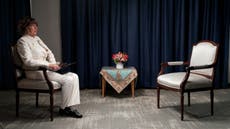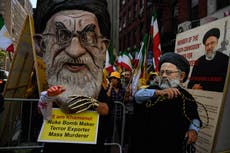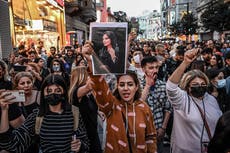Christiane Amanpour lost out on a very big interview for all the right reasons
The CNN correspondent was left with an empty studio this week when the Iranian leader failed to turn up after she refused to put on a headscarf

Your support helps us to tell the story
From reproductive rights to climate change to Big Tech, The Independent is on the ground when the story is developing. Whether it's investigating the financials of Elon Musk's pro-Trump PAC or producing our latest documentary, 'The A Word', which shines a light on the American women fighting for reproductive rights, we know how important it is to parse out the facts from the messaging.
At such a critical moment in US history, we need reporters on the ground. Your donation allows us to keep sending journalists to speak to both sides of the story.
The Independent is trusted by Americans across the entire political spectrum. And unlike many other quality news outlets, we choose not to lock Americans out of our reporting and analysis with paywalls. We believe quality journalism should be available to everyone, paid for by those who can afford it.
Your support makes all the difference.There’s a terrific moment from Mike Wallace’s interview with Iran’s Supreme Leader Ayatollah Khomeini.
It takes place just weeks after the 1979 Iranian Revolution, when students and religious conservatives overthrew the shah, stormed the US Embassy and took 50 Americans hostage. The CBS journalist had been told in advance which questions he could ask, and what topics to avoid.
Things start smoothly, and then Wallace chances his luck. “Imam, President Sadat of Egypt, a devoutly religious man, a Muslim, says what you are doing now is, quote, ‘a disgrace to Islam’,” says Wallace.
With his hand to his chest, as if underscoring how awkward he feels following up, he adds: “And he calls you, Imam — forgive me, his words not mine — ‘a lunatic’.”
The Iranian translator looks dumbstruck. Does Wallace really expect him to ask that question of the supreme leader?
He does. Khomeini, clearly angry, eventually responds: “Sadat says he is a Muslim and we are not. He is not. For he has compromised with the enemies of Islam.”
All of that was 40 years ago and Wallace, a man, had the benefit of not being asked to wear a headscarf to interview Khomeini. Yet, it is a reminder that American journalists often have a tricky time when it comes to interviewing Iranian leaders.
The most recent example was this week in New York when CNN correspondent Christiane Amanpour revealed she had missed out on an interview with Iran’s president — the conservative Ebrahim Raisi, who had been mentored by Khomeini — because she would not wear a headscarf.
“After weeks of planning and eight hours of setting up translation equipment, lights and cameras, we were ready. But no sign of President Raisi,” Amanpour tweeted, with a photograph of her seated next to an empty seat. The interview was to have taken place while Raisi was in New York to attend the UN General Assembly. Amanpour said that, 40 minutes after they were due to start, she approached by an aide who asked her to put a headscarf on.
“I politely declined. We are in New York, where there is no law or tradition regarding headscarves. I pointed out that no previous Iranian president has required this when I have interviewed them outside Iran,” she wrote. “The aide made it clear that the interview would not happen if I did not wear a headscarf.”
Some context here: Cities across Iran have in recent days been rocked by protests after Mahsa Amini, a 22-year-old Kurdish woman from the city of Saqez, died after being detained by the morality police. She was visiting Tehran on September 13 when she was arrested by police officers, who accused her of violating requirements for women to cover their hair with a hijab, a law dating to 1979 that has been variously enforced over the years. Amini subsequently died in police custody. Up to 31 civilians have been killed during the protests.
Amanpour’s non-interview came just days after Raisi gave his first interview to a western reporter, strangely enough to CBS’s Lesley Stahl. That conversation took place in Tehran and Stahl, also a veteran interviewer, noted in her report for the 60 Minutes programme that she was “told how to dress, not to sit before he did, and not to interrupt him”. She added: “We were given one hour for the interview.”
“As we ended what seemed to be a cordial conversataion, we were surprised when a member of Raisi’s staff reached up and blocked one of our cameramen from shooting our goodbyes,” she said.
There is some other context. The US and Iran have long had a hostile relationship. The US and the UK backed a 1953 coup. After the revolution, Washington imposed sanctions against Tehran, partly in an effort to try and stop it developing a nuclear weapon.
The US armed Iraq doing the bloody Iran-Iraq war and shot down a passenger airline in 1988. The US has repeatedly accused Iran of supporting terror groups such as Hezbollah.
During Barack Obama’s term as US president, the two sides restarted talks, and that resulted in the landmark 2015 nuclear deal, where some sanctions were lifted in exchange for limits to the country’s nuclear program. In 2018, Donald Trump pulled the US out of the deal and reimposed sanctions — and in 2020, Trump gave the green light to assassinate Qassim Suleimani, a powerful Iranian military leader.
Stahl received some criticism for donning the headscarf, but also asked some decent questions.
“Can we start with the negotiations on the nuclear deal? Do you want to have that deal renewed? Because you know, there are some American officials who are beginning to think that you don’t,” she said.
Raisi replied: “If it’s a good deal and fair deal, we would be serious about reaching an agreement. It needs to be lasting. There needs to be guarantees. If there were a guarantee, then the Americans could not withdraw from the deal.” He later added: “You see, the Americans broke their promises. They did it unilaterally. They said that, ‘I am out of the deal.’ Now making promises is becoming meaningless.”
These are all issues Amanpour planned to follow up on. “Protests are sweeping Iran and women are burning their hijabs after the death last week of Mahsa Amini, following her arrest by the ‘morality police’. Human rights groups say at least 8 have been killed,” she tweeted. “I planned to ask President Raisi about all this and much more.”
Amanpour was no doubt disappointed to miss out on the interview. But what does seem clear is that sometimes, the sight of an empty chair, along with the reason why the person choose not to sit in it, can be just as insightful and informing as an interview itself.



Join our commenting forum
Join thought-provoking conversations, follow other Independent readers and see their replies
0Comments